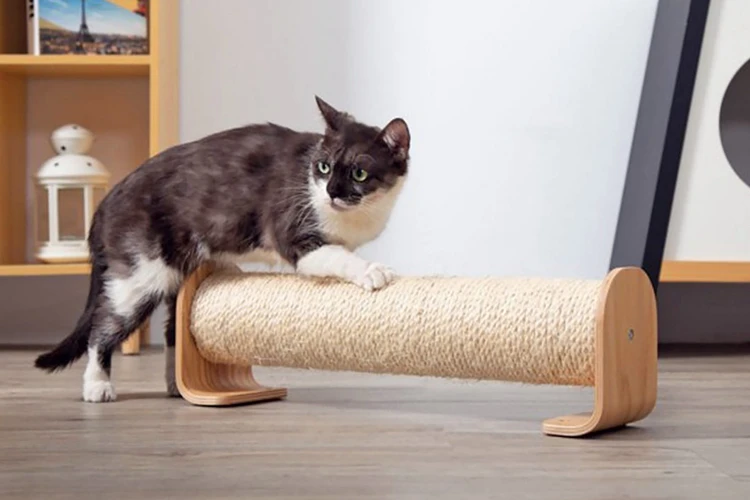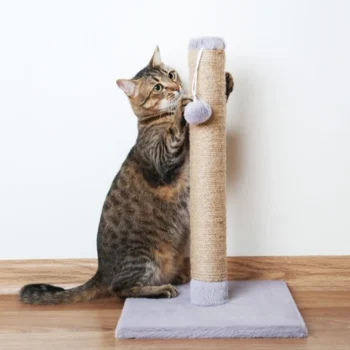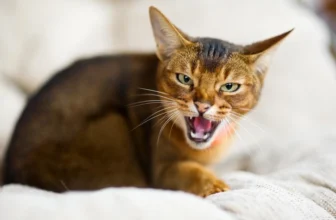We all love our American Wirehair cats, but we don’t love the scratches they leave on our furniture. It can be frustrating to have a beautiful sofa ripped apart by sharp claws. Fortunately, there’s a solution: a scratching post. However, getting your cat to actually use it can be a challenge. Fear not, because in this article we’ll guide you through the process of teaching your American Wirehair to use a scratching post step-by-step. So, grab a cup of coffee and let’s get started!
Why Use a Scratching Post?

It might be perplexing to some cat owners why their American Wirehair incessantly scratches at furniture. However, this behavior is perfectly natural and an indication of their territorial nature. To prevent damage to your furniture, it is crucial to provide your cat with an appropriate outlet for their scratching needs. The solution is to introduce a scratching post, which can serve as a satisfying substitute for your cat’s scratching behavior. In this article, we will dive into why it is beneficial to use a scratching post, and how to choose the right one for your American Wirehair’s needs. Additionally, we will provide tips for training your cat to use the post, as well as maintaining their interest in it over time. Don’t miss out on our recommended internal link for more information on why American Wirehairs scratch furniture: am-wirehairs-scratch-furniture.
Preventing Furniture Damage
As a cat owner, seeing your American Wirehair scratching your furniture can be frustrating. However, this behavior is natural and essential for your cat’s well-being. To prevent furniture damage, it is crucial to provide your feline friend with a scratching post. Not only will it save your furniture, but it will also provide your cat with a designated area to scratch and stretch.
Repeatedly scratching the same spot can damage the furniture beyond repair, resulting in expensive repair costs or replacement. In some cases, it may even lead to declawing, which is a painful and inhumane procedure. Investing in a high-quality scratching post is a more humane and cost-effective solution.
Scratching also allows your American Wirehair to shed the outer layer of their claws, preventing them from overgrowing and causing discomfort. Encouraging your cat to scratch on the scratching post will help keep their claws healthy while providing them with an outlet for their natural scratching behavior.
Without a scratching post, your American Wirehair may resort to scratching different surfaces around the house, including your furniture, rugs, or walls. This behavior is not because they are misbehaving; it’s part of their territorial nature. Cats use their claws to mark their territory, and scratching serves as a way to communicate their presence to other animals. Providing your cat with a scratching post will not only save your furniture but also satisfy their instinctual needs.
To learn more about why scratching posts are essential and how to choose the right one for your American Wirehair, check out our article on the best scratching posts for American Wirehairs. Alternatively, if you are looking for alternatives to declawing, read our article on American Wirehair declaw alternatives.
Stretching and Marking Territory
The act of scratching is not only a way for your American Wirehair to stretch their muscles, but it’s also a natural way of marking their territory. By leaving behind their scent from the glands in their paws, they are claiming ownership of their space. It’s important to understand this instinctual behavior, as trying to stop your cat from scratching altogether can be damaging to their physical and mental well-being.
So, what can you do? Provide them with a specific area for scratching, such as a scratching post or pad. This will allow them to satisfy their need to stretch and mark their territory without causing damage to your furniture or carpet.
By offering an appropriate scratching area, you are also creating clear boundaries for your cat. They will learn where they are allowed to scratch, and where they are not. This helps to eliminate any confusion and reduces the chance of them scratching in inappropriate places.
Don’t forget, though, that furniture scratching is still a natural behavior. Try to avoid punishing your American Wirehair for scratching or showing aggression as a result of wanting to claim their territory. Instead, redirect their behavior to the appropriate scratching surface.
If you find your cat continually scratching your furniture, it may be worth considering purchasing scratch-resistant furniture or using a deterrent spray on the affected areas. However, it’s essential to understand that scratching is a part of your cat’s innate behavior and territory-marking. Trying to stop this could lead to behavior problems and stress for your furry friend.
More information on territorial nature of American WH and their scratching can be found at /territorial-nature-american-wirehairs-furniture-scratching/. However, if you want to learn how to teach your American Wirehair to stop scratching furniture, you can read our article here.
Choosing the Right Scratching Post

When it comes to choosing a suitable scratching post for your American Wirehair, the options in the market can be overwhelming. You want to ensure that the post is not only visually appealing to your cat but also serves its purpose in protecting your furniture. The right scratching post can make a big difference in whether your cat chooses to scratch your couch or the post. Here are some factors to consider when selecting the best scratching post for your American Wirehair.
Material
When choosing a scratching post for your American Wirehair, the material it’s made of is an important factor to consider. Below is a table that compares the pros and cons of popular scratching post materials:
| Material | Pros | Cons |
|---|---|---|
| Sisal rope | – Durable and long-lasting – Provides a satisfying texture for scratching – Easy to find in stores |
– May shed fibers and create mess – Can be more expensive than other materials |
| Cardboard | – Inexpensive option – Provides a satisfying texture for scratching – Can be replaced easily |
– May not be as durable as other materials – Can create mess and debris |
| Carpet | – Provides a texture similar to furniture for scratching – Easy to find in stores |
– May encourage scratching on furniture with similar texture – Can be difficult to clean and maintain |
| Wood | – Sturdy and durable option – Provides a natural texture for scratching – Can be aesthetically pleasing |
– Can be more expensive than other materials – Limited options in stores |
It’s important to note that while each material has its own benefits and drawbacks, the most important factor is providing your American Wirehair with a post that they enjoy using. Consider your cat’s preferences and personality when selecting a scratching post material and design. Experiment with different materials and shapes until you find the perfect fit for your feline friend.
Height and Stability
When choosing a scratching post for your American Wirehair, it is important to consider its height and stability. Here are some things to keep in mind:
- Height: The scratching post should be tall enough for your cat to stretch out fully and scratch comfortably. A post that is too short may not be satisfying for your cat and may not deter them from scratching on furniture. Aim for a post that is at least 30 inches tall.
- Stability: A wobbly or unstable scratching post can be frustrating for your cat and may deter them from using it. Look for a post that has a solid, sturdy base and does not wobble or tip over easily. This is especially important if your cat is larger or more energetic.
- Weight: In addition to stability, consider the weight of the scratching post. A heavier post will be more difficult for your cat to knock over or move, making it a more appealing option for scratching.
- Multiple Levels: If you have multiple cats or a particularly active cat, consider a scratching post with multiple levels. This not only provides more opportunities for scratching, but also allows cats to jump and climb, satisfying their natural instincts.
By taking these factors into consideration, you can ensure that your American Wirehair has a scratching post that is both satisfying and safe to use.
Location
When it comes to choosing the right location for your American Wirehair’s scratching post, consider the following:
- Visibility: Place the scratching post in a visible area of your home, where your cat will see it and be reminded to use it frequently.
- Traffic: Choose a location with high traffic, such as the living room or hallway, where your American Wirehair will often pass by and be reminded to scratch.
- Proximity: Place the scratching post near the areas where your cat already likes to scratch, such as furniture or walls. Gradually move it to a more desirable location over time.
- Accessibility: Make sure the scratching post is easily accessible for your cat. If it is too high or difficult to reach, they may lose interest and go back to scratching your furniture.
- Privacy: Cats also enjoy having a sense of privacy when scratching, so avoid placing the scratching post in a busy or noisy area.
By considering these factors, you can choose the optimal location for your cat’s scratching post that encourages frequent use and prevents furniture damage.
Number of Posts
When it comes to choosing the right scratching post for your American Wirehair, the number of posts you provide is important. In general, it’s recommended to have at least one scratching post per cat in your household, plus an additional one. So if you have two American Wirehairs, you should have three scratching posts available for them to use. This helps to prevent territorial disputes and ensures that each cat has access to a scratching post when they need it.
Benefits of Having Multiple Posts:
- Prevents territorial disputes among cats
- Ensures that each cat has access to a scratching post when needed
- Provides variety and stimulation for your cat
- Increases the likelihood of your cat using a scratching post instead of furniture
Having multiple scratching posts in different areas of your home also provides your American Wirehair with variety and stimulation. Cats love to scratch on different textures and surfaces, so having posts made of various materials like sisal, carpet, or cardboard can keep them entertained and engaged.
It’s important to note that simply having multiple posts isn’t enough – you also need to make sure they are placed in strategic locations throughout your home. Place them in areas where your cat spends a lot of time, like near their food and water bowls or near their favorite sleeping spots. Having a post in each room can also be helpful.
By providing multiple scratching posts that are placed in strategic locations throughout your home, you can increase the likelihood that your American Wirehair will use the post instead of your furniture. It also ensures that each cat has access to a post whenever they need to stretch and scratch, promoting a happier and healthier feline household.
Training Your American Wirehair to Use the Scratching Post

Teaching your feline to use a scratching post can seem daunting, especially if they are already set in their ways of using furniture or carpets to sharpen their claws. However, with patient and consistent training, it is possible to redirect your American Wirehair’s scratching behavior to a designated post. In this section, we will explore different training methods and deterrents to achieve the best results. Let’s dive in!
Reward-Based Training
Training your American Wirehair to use a scratching post is much easier when you use reward-based training. By rewarding your cat for using the post, you can show it that scratching in that location is desirable and will lead to a positive experience. Here are some tips for using this method effectively:
- Choose the right rewards: When choosing rewards, consider what your cat likes. It could be treats, praise, or playtime with its favorite toy.
- Timing is everything: Timing is crucial when training with rewards. Make sure you reward your cat immediately after it uses the scratching post, so it associates the positive experience with the desired behavior.
- Be consistent: Consistency is key when training your cat. Make sure you reward it every time it uses the scratching post, at least in the early stages of training, to reinforce the behavior.
- Don’t punish: When training with rewards, it’s important to avoid punishing your cat for scratching elsewhere. Punishment can make your cat associate negative experiences with certain activities or items and could make it less likely to use the scratching post.
By using reward-based training and being consistent in your approach, your American Wirehair will soon learn to associate the scratching post with positive rewards and be more likely to use it in the future.
Deterrents for Undesirable Scratching
It’s important to discourage your American Wirehair from scratching furniture or other unsuitable items in your home. To do this, you can use a few effective deterrents that will make these items less appealing to your cat. Here are some options:
| Deterrent Option | How it Works |
|---|---|
| Double-sided tape | Applying double-sided tape on the furniture or object that your cat likes to scratch will make it uncomfortable for them to use. The sticky texture will discourage your cat from using it as a scratching post. |
| Aluminum foil | Similar to double-sided tape, aluminum foil can be placed on the furniture or object to deter your cat from scratching in that spot. The crinkly texture and shiny appearance can be unpleasant for them to use. |
| Bitter sprays | There are sprays available at pet stores that have a bitter taste and smell. You can apply these to the furniture or object to make it unappealing for your cat to scratch. However, make sure to test a small area first to ensure it won’t damage the item or stain it. |
| Offering alternatives | If your cat has a favorite scratching spot, consider placing a scratching post nearby to redirect their attention. You can also try offering different types of scratching posts with different materials or textures to see which your cat prefers. |
By using these deterrents, your American Wirehair will be less likely to scratch your furniture or household items. Remember to pair this with redirecting your cat’s attention to a suitable scratching post, and continue to reward positive behavior.
Redirecting Your Cat’s Scratching to the Post
One of the most important aspects of teaching your American Wirehair to use a scratching post is redirecting their scratching behavior to the post itself. Here are a few key steps to follow:
1. Place the Post Strategically
Make sure the scratching post is placed in a prominent location in your home. Cats often scratch to mark their territory, so placing the post in a room where your cat spends a lot of time will help encourage them to use it instead of your furniture. Consider placing the post near your cat’s favorite napping spot or near a window where they can watch the world outside.
2. Encourage Your Cat to Explore the Post
Cats are naturally curious, so let your cat explore the scratching post on their own. You can try rubbing the post with catnip or using treats to lure your cat over to the post. When your cat approaches the post, gently guide their claws towards the surface to show them how to scratch it. Positive reinforcement through treats or praise when they do use it can help a lot.
3. Deter Scratching on Undesirable Surfaces
It’s important to discourage your cat from scratching on your furniture or other undesirable surfaces. You can do this by making those surfaces less appealing. Covering your couch with a sheet or placing double-sided tape on the corners can deter your cat from scratching there. Providing a comfortable alternative like a cozy bed or cat tree nearby can also help.
4. Reward and Praise Good Behavior
When your cat starts using the scratching post regularly, be sure to reward them with treats and praise. Positive reinforcement will help your cat understand that using the post is a good thing and that it brings positive results.
Remember, training your American Wirehair to use a scratching post takes time and patience. Be consistent in your training approach, and don’t give up if your cat doesn’t immediately take to the post. With persistence and positive reinforcement, you can teach your cat to scratch where they are supposed to, saving your furniture in the process.
Maintaining Your American Wirehair’s Interest in the Scratching Post
After carefully selecting the right scratching post and successfully training your American Wirehair to use it, the next challenge is maintaining their interest in it over time. While cats are naturally drawn to scratching, their attention spans can wane quickly. In this section, we will explore some effective strategies for keeping your American Wirehair engaged with their scratching post so that they continue to use it and avoid damaging your furniture. So, how can you ensure that your cat never loses interest in their scratching post? Let’s dive in and find out!
Regular Maintenance and Cleaning
Keeping your American Wirehair’s scratching post clean and well-maintained is key to ensuring their continued use of the post. Here are some tips for keeping the post in tip-top shape:
- Regular Inspection: Check the post regularly for damage or wear and tear so that you can repair or replace it before it becomes unusable.
- Clean-up Debris: Clean the area around the post and remove any debris such as cat hair, dirt or litter that might accumulate there over time.
- Wash with Soap and Water: Use soap and water to clean the post. Make sure to rinse and dry it completely before returning it to your cat.
- Rotation: Rotate the post to refresh your cat’s interest. Try turning it upside down, moving it to a new location or changing its orientation. This will help to maintain your cat’s curiosity and prevent boredom.
- Use Cat-friendly Disinfectant: If your cat has been scratching the post for a long time it is important to keep it disinfected. Use a cat-friendly disinfectant to kill any germs or bacteria that may have accumulated on the post.
By following these tips, you will help your cat stay interested in their scratching post, and you will be able to avoid any unpleasant odors or stains that could reduce their motivation to use it. Maintaining the post regularly and cleaning it well can also extend its lifespan so you can both enjoy it for years to come.
Adding Toys and Catnip
As your American Wirehair gets used to their scratching post, you may need to spice things up a bit to keep their interest. One way to do this is by adding toys and catnip to their scratching post area.
Why add toys and catnip?
Toys and catnip can provide extra stimulation and motivation for your cat to use their scratching post. The toys can be hung from the top of the post or placed on the ground next to it, while catnip can be sprinkled on and around the post.
What toys should you choose?
Not all toys are created equal when it comes to scratching posts. It’s best to choose toys that are designed for scratching or climbing, such as small scratching pads, hanging balls, or climbing tubes. Avoid toys with sharp edges or loose strings that could be a choking hazard.
How to use catnip?
Catnip can be a great incentive for your cat to use their scratching post. Simply sprinkle it on and around the post. However, not all cats are affected by catnip. If your cat doesn’t seem to respond to it, don’t worry.
To summarize, adding toys and catnip to your American Wirehair’s scratching post area can help maintain their interest and motivate them to continue using it. Choose appropriate toys and use catnip as a fun incentive, but remember that not all cats will respond to it.
Conclusion
In conclusion, teaching your American Wirehair to use a scratching post is an essential aspect of cat ownership. It not only prevents furniture damage but also provides a healthy outlet for your cat’s natural instincts to stretch and mark territory.
Choosing the right scratching post is crucial, and factors such as material, height, stability, location, and the number of posts are all important considerations. It’s also essential to train your cat to use the post through reward-based training, deterrents for undesirable scratching, and redirecting their scratching behavior to the post.
Maintaining your cat’s interest in the scratching post is key to its continued use. This can be achieved through regular maintenance and cleaning, as well as adding toys and catnip to make the post more appealing.
Overall, with patience and perseverance, teaching your American Wirehair to use a scratching post can help create a happy and healthy environment for both cat and owner. By following the tips and techniques outlined in this article, the scratching post can become an essential and beloved part of your cat’s life.
Frequently Asked Questions
What if my American Wirehair won’t use the scratching post?
It may take some patience and persistence to train your cat to use the scratching post, but there are several effective deterrents and redirection techniques you can try.
How many scratching posts should I have in my home?
It’s recommended to have at least one scratching post per cat, plus an additional post if you have a multi-level home.
What is the best material for a scratching post?
Sisal rope is a popular material for scratching posts, as it is durable and has a rough texture that is appealing to cats.
Should I punish my American Wirehair for scratching furniture?
No, punishment is not an effective method of training and can harm your relationship with your cat. It’s important to instead focus on redirecting their scratching behavior to the scratching post.
Can I build my own scratching post?
Yes, you can find DIY instructions online to make your own scratching post using materials like cardboard, carpet, or sisal rope.
How often should I clean the scratching post?
You should clean and inspect the scratching post regularly, at least once a week, to remove any debris and ensure it is still stable and usable.
What if my American Wirehair only scratches horizontally?
You can try providing a horizontal scratching surface, such as a cardboard scratcher, in addition to a vertical scratching post.
Do I need to trim my cat’s claws if they use a scratching post?
It’s still recommended to trim your cat’s claws regularly, even if they use a scratching post, to prevent them from becoming too long and sharp.
Can I train an older American Wirehair to use a scratching post?
Yes, cats of all ages can learn to use a scratching post with patience and positive reinforcement training.
What if my American Wirehair prefers to scratch other surfaces like carpet or curtains?
You can try using double-sided tape or a citrus spray as a deterrent on those surfaces, while also providing appealing scratching options like a scratching post or cardboard scratcher.







